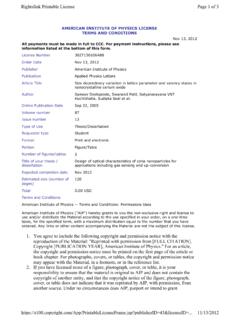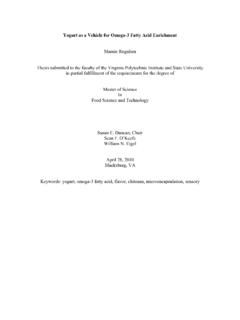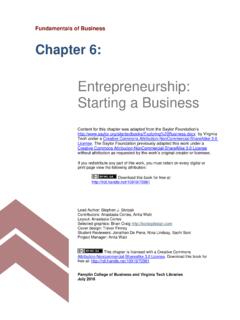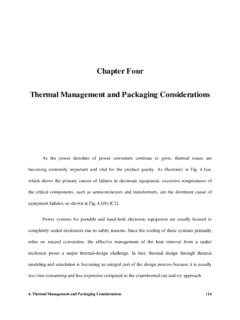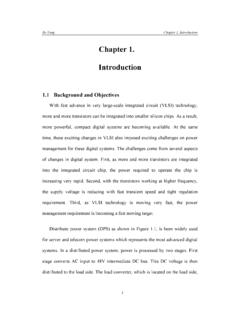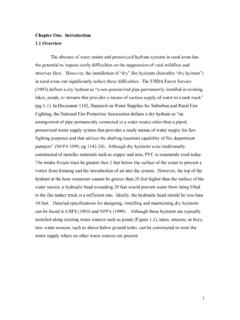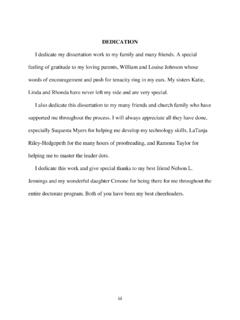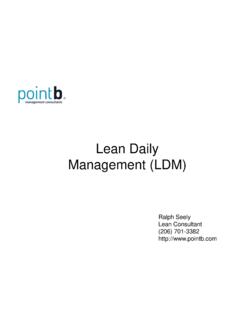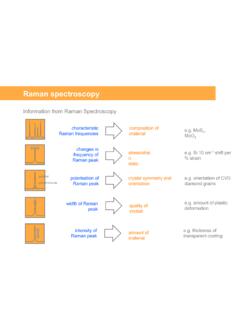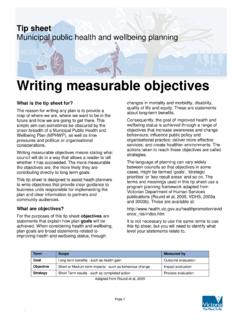Transcription of Operations Management - Virginia Tech
1 Fundamentals of Business Chapter 9: Operations Management Content for this chapter was adapted from the Saylor Foundation s by Virginia Tech under a Creative Commons Attribution-NonCommercial-ShareAlike License. The Saylor Foundation previously adapted this work under a Creative Commons Attribution-NonCommercial-ShareAlike License without attribution as requested by the work s original creator or licensee. If you redistribute any part of this work, you must retain on every digital or print page view the following attribution: Download this book for free at: Lead Author: Stephen J.
2 Skripak Contributors: Richard Parsons, Anastasia Cortes, Anita Walz Layout: Anastasia Cortes Selected graphics: Brian Craig Cover design: Trevor Finney Student Reviewers: Jonathan De Pena, Nina Lindsay, Sachi Soni Project Manager: Anita Walz This chapter is licensed with a Creative Commons Attribution-Noncommercial-Sharealike License. Download this book for free at: Pamplin College of Business and Virginia Tech Libraries July 2016 200 Download this book for free at: Chapter 9 Chapter 9 Operations Management Learning objectives 1) Define Operations Management and discuss the role of the Operations manager in a manufacturing company.
3 2) Describe the decisions and activities of the Operations manager in overseeing the production process in a manufacturing company. 3) Explain how to create and use both PERT and Gantt charts. 4) Explain how manufacturing companies use technology to produce and deliver goods in an efficient, cost-effective manner. 5) Describe the decisions made in planning the product delivery process in a service company. 6) List the characteristics that distinguish service Operations from manufacturing Operations and identify the activities undertaken to manage Operations in a service organization.
4 7) Explain how manufacturing and service companies alike use total quality Management and outsourcing to provide value to customers. Chapter 9 Download this book for free at: 201 The Challenge: Producing quality Jetboards The product development process can be complex and lengthy. It took sixteen years for Bob Montgomery and others at his company to develop the PowerSki Jetboard, and this involved thousands of design changes. It was worth it, though: the Jetboard was an exciting, engine-propelled personal watercraft - a cross between a high-performance surfboard and a competition water-ski/wakeboard that received extensive media attention and rave reviews.
5 It was showered with honors, including Time magazine s Best Invention of the Year Stories about the Jetboard appeared in more than fifty magazines around the world, and it was featured in several movies, over twenty-five TV shows, and on Montgomery and his team at PowerSki enjoyed taking their well-deserved bows for the job they did designing the product, but having a product was only the beginning for the company. The next step was developing a system that would produce high- quality Jetboards at reasonable prices. Before putting this system in place, PowerSki managers had to address several questions.
6 : The PowerSki Jetboard. To see it in action, visit the company s Web site at Watch the videos that demonstrate what the Jetboard can do. 202 Download this book for free at: Chapter 9 What kind of production process should they use to make the Jetboards? How large should their production facilities be, and where should they be located? Where should they buy needed materials? What systems will be needed to control the production process and ensure a quality product? Answering these and other questions helped PowerSki set up a manufacturing system through which it could accomplish the most important task that it had set for itself: efficiently producing quality Jetboards.
7 Operations Management in Manufacturing Like PowerSki, every organization whether it produces goods or provides services sees Job 1 as furnishing customers with quality products. Thus, to compete with other organizations, a company must convert resources (materials, labor, money, information) into goods or services as efficiently as possible. The upper-level manager who directs this transformation process is called an Operations manager. The job of Operations Management (OM) consists of all the activities involved in transforming a product idea into a finished product.
8 In addition, Operations managers are involved in planning and controlling the systems that produce goods and services. In other words, Operations managers manage the process that transforms inputs into outputs. Figure illustrates these traditional functions of Operations Management . Like PowerSki, all manufacturers set out to perform the same basic function: to transform resources into finished goods. To perform this function in today s business environment, manufacturers must continually strive to improve operational efficiency. They must fine-tune their production processes to focus on quality , to hold down the costs of Chapter 9 Download this book for free at: 203 materials and labor, and to eliminate all costs that add no value to the finished product.
9 Making the decisions involved in the effort to attain these goals is another job of Operations managers. Their responsibilities can be grouped as follows: Production planning. During production planning, managers determine how goods will be produced, where production will take place, and how manufacturing facilities will be laid out. Production control. Once the production process is under way, managers must continually schedule and monitor the activities that make up that process. They must Figure : The Transformation Process 204 Download this book for free at: Chapter 9 solicit and respond to feedback and make adjustments where needed.
10 At this stage, they also oversee the purchasing of raw materials and the handling of inventories. quality control. The Operations manager is directly involved in efforts to ensure that goods are produced according to specifications and that quality standards are maintained. Let s take a closer look at each of these responsibilities. Planning the Production Process The decisions made in the planning stage have long-range implications and are crucial to a firm s success. Before making decisions about the Operations process, managers must consider the goals set by marketing managers.
